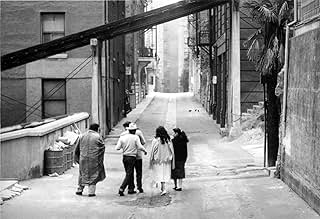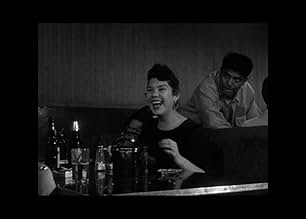IMDb RATING
6.6/10
1.4K
YOUR RATING
Follows a family of Native Americans living in the City of Angels.Follows a family of Native Americans living in the City of Angels.Follows a family of Native Americans living in the City of Angels.
- Awards
- 1 win
Tom Reynolds
- Tommy
- (as Tommy Reynolds)
- Director
- Writer
- All cast & crew
- Production, box office & more at IMDbPro
Storyline
Did you know
- TriviaKent Mackenzie borrowed equipment from industrial film makers Parthenon Pictures and used the unused "ends" of thousand-foot reels of 35mm film, according to an article in the 12 March 1961 edition of the New York Times.
- GoofsIn a scene where an older man is heard singing and playing an instrument under a tree, he is not doing corresponding actions in a long-shot.
- ConnectionsFeatured in Los Angeles Plays Itself (2003)
Featured review
This was one of the first films to deal with the contemporary lives of Native Americans. It's still one of the very few pieces to deal with the Native urban diaspora, in this case in the no-longer existing LA neighborhood of Bunker Hill, in 1961.
More broadly, "Exiles" is a film about displacement, and finding oneself in a state of displacement, of having one's truest self be the displaced self. It focuses on a young, married couple who hardly see each other. The husband is out cavorting and fighting with other young quasi- hooligans. The wife is mostly alone, or abandoned at the cinema. The only scene where we sense that she is bonding with anybody is when she is in bed, in an officially asexual way, with a girlfriend.
As an empathetic depiction of the alienation that occurs when people are divorced from their (essentially extinct) culture, one cannot help but admire the film. Yet, I was left with the troubling sense that its depiction of characters driven to cling to each other based on the most basic similarities, such as tribe,race, and, perhaps most importantly in the eyes of the filmmakers, gender, was decidedly heteronormative. I wouldn't go so far as to call the film homophobic. The only brazenly gay characters, a couple of dudes dancing in a "straight" bar, are depicted in a neutral light. Yet, the isolation of man from woman, and "debauched" same-sex mingling are depicted as the prime symptoms of alienation under colonialism and capitalism. This attitude was all too common amid leftists in the era that the film was made.
For contemporary viewers, perhaps the most rewarding thing about The Exiles is its luscious black and white cinematography of the now destroyed Bunker Hill district of Los Angeles. As a documentary extra on the DVD further attests, Bunker Hill was a dynamic, multinational district that was home to immigrant families and retired professionals. Soon after this movie was completed, the neighborhood was bulldozed in an attempt to "improve" LA. In this way, the film seems like a depiction of two fallen cultures: the exiles of crushed Native American culture inhabiting an urban landscape that is itself now only a celluloid ghost.
More broadly, "Exiles" is a film about displacement, and finding oneself in a state of displacement, of having one's truest self be the displaced self. It focuses on a young, married couple who hardly see each other. The husband is out cavorting and fighting with other young quasi- hooligans. The wife is mostly alone, or abandoned at the cinema. The only scene where we sense that she is bonding with anybody is when she is in bed, in an officially asexual way, with a girlfriend.
As an empathetic depiction of the alienation that occurs when people are divorced from their (essentially extinct) culture, one cannot help but admire the film. Yet, I was left with the troubling sense that its depiction of characters driven to cling to each other based on the most basic similarities, such as tribe,race, and, perhaps most importantly in the eyes of the filmmakers, gender, was decidedly heteronormative. I wouldn't go so far as to call the film homophobic. The only brazenly gay characters, a couple of dudes dancing in a "straight" bar, are depicted in a neutral light. Yet, the isolation of man from woman, and "debauched" same-sex mingling are depicted as the prime symptoms of alienation under colonialism and capitalism. This attitude was all too common amid leftists in the era that the film was made.
For contemporary viewers, perhaps the most rewarding thing about The Exiles is its luscious black and white cinematography of the now destroyed Bunker Hill district of Los Angeles. As a documentary extra on the DVD further attests, Bunker Hill was a dynamic, multinational district that was home to immigrant families and retired professionals. Soon after this movie was completed, the neighborhood was bulldozed in an attempt to "improve" LA. In this way, the film seems like a depiction of two fallen cultures: the exiles of crushed Native American culture inhabiting an urban landscape that is itself now only a celluloid ghost.
- treywillwest
- May 11, 2015
- Permalink
- How long is The Exiles?Powered by Alexa
Details
- Release date
- Country of origin
- Official site
- Language
- Also known as
- Изгнанники
- Filming locations
- See more company credits at IMDbPro
Box office
- Budget
- $539 (estimated)
- Gross US & Canada
- $30,945
- Opening weekend US & Canada
- $8,448
- Jul 13, 2008
- Gross worldwide
- $30,945
- Runtime1 hour 12 minutes
- Color
- Sound mix
- Aspect ratio
- 1.37 : 1
Contribute to this page
Suggest an edit or add missing content





















